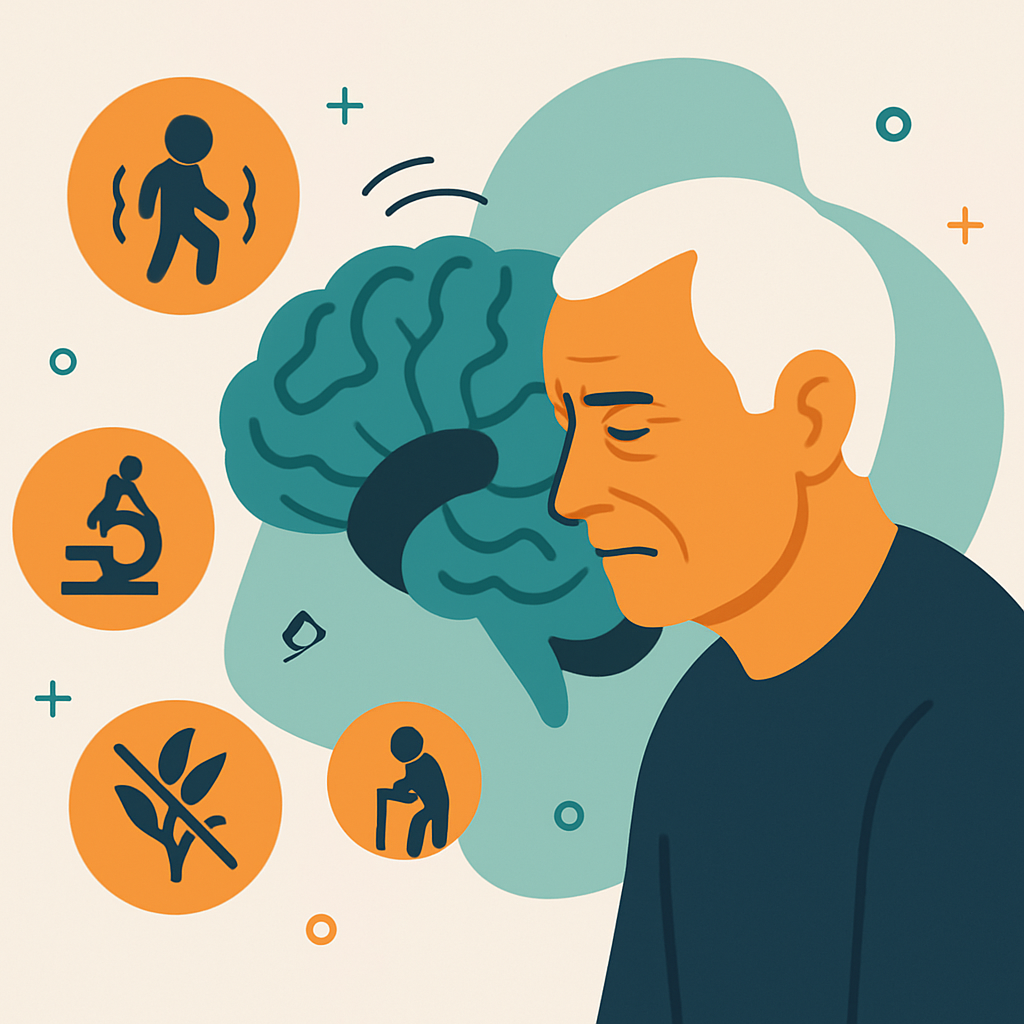Parkinson’s disease (PD) is currently the fastest-growing neurological condition worldwide. According to the World Health Organization (WHO), more than 8.5 million people were living with Parkinson’s in 2019, and this number may exceed 12 million by 2040. With global populations aging, Parkinson’s is becoming a major challenge—not just for patients but also for caregivers and healthcare systems.
This article offers a comprehensive guide to Parkinson’s disease: causes, stages, symptoms, risk factors, diet, treatments, and its global burden, with insights from WHO, Mayo Clinic, Cleveland Clinic, and NINDS.
What Is Parkinson’s Disease?
Parkinson’s disease is a chronic, progressive neurodegenerative disorder caused by the gradual loss of dopamine-producing neurons in the substantia nigra (a part of the brain responsible for movement control).
Since dopamine is essential for smooth, coordinated muscle activity, its decline leads to hallmark motor issues like tremors, rigidity, slowness of movement, and poor balance.
But Parkinson’s goes beyond movement problems—patients also experience fatigue, depression, constipation, sleep disturbances, and cognitive decline (Mayo Clinic, NINDS).
What Causes Parkinson’s Disease?
The exact cause remains unclear, but experts agree it results from a mix of genetic, environmental, and biological factors:
- Genetic mutations (LRRK2, PARK2, PINK1) cause about 5–15% of cases (Cleveland Clinic).
- Environmental triggers such as pesticide exposure, air pollution, and heavy metals increase risk (WHO).
- Age & gender: Most cases appear after 60, and men are 1.5 times more likely to develop Parkinson’s (Mayo Clinic).
- Abnormal protein deposits (alpha-synuclein/Lewy bodies) disrupt normal brain signaling (NCBI).
Types of Parkinson’s Disease
According to Parkinson’s Foundation & Parkinson’s UK, Parkinson’s manifests in different forms:
- Idiopathic Parkinson’s Disease – The most common type, with no clear cause.
- Genetic/Familial Parkinson’s – Inherited mutations linked to the disease.
- Secondary Parkinsonism – Resulting from brain injury, drugs, or toxins.
- Atypical Parkinsonism – Rare syndromes like MSA and PSP that mimic Parkinson’s but progress faster.
Stages of Parkinson’s: The Hoehn and Yahr Scale
- Stage 1 – Mild, symptoms only on one side.
- Stage 2 – Both sides affected, mild walking issues.
- Stage 3 – Balance problems and frequent falls, independence declines.
- Stage 4 – Severe disability, daily assistance required.
- Stage 5 – Bedridden or wheelchair-bound, full-time care needed.
Recognizing the Symptoms
Motor Symptoms
- Tremors (hands, arms, legs, jaw)
- Slowed movement (bradykinesia)
- Muscle rigidity
- Poor balance and posture
Non-Motor Symptoms
- Sleep disturbances (insomnia, REM disorder)
- Loss of smell, fatigue
- Constipation, digestive problems
- Anxiety, depression, apathy
- Cognitive decline and dementia in later stages
(Sources: WHO, Mayo Clinic, NINDS)
Diagnosis: How Doctors Identify Parkinson’s
There’s no single test for Parkinson’s. Diagnosis includes:
- Neurological assessment – Checking bradykinesia plus tremor/rigidity.
- Medical history review – To rule out other conditions.
- Imaging (MRI, PET, SPECT) – Helpful but not conclusive.
- Emerging tests – Detecting alpha-synuclein in skin biopsies offers promise (NCBI).
WHO warns that in many countries, lack of specialists delays diagnosis.
Managing Parkinson’s Beyond Medication
While Levodopa and dopamine agonists remain essential, non-drug therapies are equally important:
- Exercise & physiotherapy – Cycling, walking, tai chi, Rock Steady Boxing.
- Speech therapy – Helps with voice clarity and swallowing.
- Occupational therapy – Assists daily tasks and independence.
- Mind-body practices – Yoga, dance, and meditation for mental well-being.
WHO recognizes rehabilitation as a cornerstone of long-term management.
Can Parkinson’s Be Prevented?
Though not entirely preventable, research suggests lifestyle factors may lower risk:
- Regular exercise for brain health.
- Mediterranean diet rich in antioxidants & omega-3s.
- Avoiding toxins (pesticides, heavy metals).
- Healthy routines – Stress control, mental stimulation, and quality sleep.
Nutrition and Parkinson’s: A Supportive Role
- Fruits, vegetables, and whole grains for antioxidants.
- Omega-3 fatty acids (fish, flaxseed, walnuts).
- High fiber + hydration to manage constipation.
- Protein timing – High-protein meals should be separated from levodopa for better absorption (Cleveland Clinic).
Risk Factors
Factors that raise Parkinson’s risk (Mayo Clinic, WHO, Johns Hopkins):
- Unchangeable: Age 60+, male gender, family history/genetics.
- Environmental: Air pollution, pesticide exposure, solvents, head trauma.
- Lifestyle: Sedentary living, poor diet, chronic stress.
The Global Burden
- 81% rise in disability linked to Parkinson’s between 2000–2019 (WHO).
- Deaths have more than doubled in the same period.
- India faces a projected 168% increase by 2050, with 2.8 million cases (Times of India, 2023).
- Parkinson’s is officially declared a global public health crisis (NINDS).
FAQs on Parkinson’s Disease
Q1. What’s the first sign?
Usually a tremor, but also loss of smell or handwriting changes.
Q2. Four hallmark symptoms?
Tremor, bradykinesia, rigidity, and balance problems.
Q3. Is it curable?
No cure yet, but treatments and therapies manage symptoms.
Q4. Can it be prevented?
Not fully, but exercise, healthy diet, and toxin avoidance help.
Q5. Life expectancy?
With proper care, many live nearly normal lifespans.
Q6. Is it hereditary?
Only 5–15% of cases are genetic.
Q7. Does it only affect movement?
No, it also impacts mood, digestion, and cognition.
Q8. Best diet?
Mediterranean diet with antioxidants and omega-3s.
Q9. When is full-time care required?
Stage 5 usually requires round-the-clock support.
Q10. How big is the global burden?
Cases have more than doubled in 25 years—making it the fastest-growing neurological disorder (WHO).
Conclusion: Moving Forward in Parkinson’s Care
Parkinson’s disease is progressive but manageable. With early detection, lifestyle support, medical treatment, and rehabilitation, patients can maintain independence and live meaningful lives.
As cases surge worldwide, awareness, research, and better care access will play the most crucial roles in reducing the burden of this disease.
Sources : –
- World Health Organization (WHO) – Parkinson’s Disease Factsheet
https://www.who.int/news-room/fact-sheets/detail/parkinson-s-disease - Mayo Clinic – Parkinson’s Disease Overview
https://www.mayoclinic.org/diseases-conditions/parkinsons-disease - Cleveland Clinic – Parkinson’s Disease: Causes, Symptoms & Treatment
https://my.clevelandclinic.org/health/diseases/8520-parkinsons-disease - NINDS (National Institute of Neurological Disorders and Stroke)
https://www.ninds.nih.gov/health-information/disorders/parkinsons-disease - Parkinson’s Foundation – Understanding Parkinson’s
https://www.parkinson.org/understanding-parkinsons - Parkinson’s UK – Types and Symptoms
https://www.parkinsons.org.uk/information-and-support/what-parkinsons
Read our full detail blog on polio – https://newsarmour.com/polio-causes-symptoms-prevention-eradication-guide/





